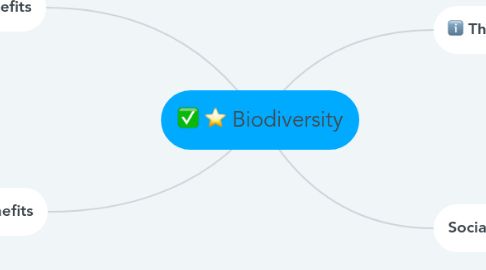Biodiversity
by Evan Verikios

1. Economic Benefits
1.1. • Free pollination many insects and birds provide the valuable service of pollinating crop plants for free.
1.2. Pest control natural predators can act as controls for agricultural pests.
2. Environment Benefits
2.1. Water purification—wetlands provide wildlife with habitat, help maintain stable water levels, control salinity, and act as filters against contaminants to improve water quality.
2.2. Pollution absorption—plants and trees are a source of oxygen, and also absorb carbon dioxide and some pollutants.
2.3. Erosion control trees and other vegetation reduce soil erosion and provide wildlife habitat at the same time.
2.4. Waste management—soils rich in organisms, such as fungi, bacteria and arthropods, are healthier because these organisms break down organic matter and minerals into parts that can be utilized by other organisms, such as food for plants.
3. Threats to Biodiversity
3.1. Pollution
3.2. Climate change
3.3. Invasive species
3.4. Habitat destruction
4. Social Benefits
4.1. Outdoor recreation—hiking, camping, bird watching, canoeing, and other outdoor activities provide enjoyment for many people.
4.2. Revenue from tourism—tourists who want to experience nature contribute revenue to the economy, which means jobs for many Canadians.
4.3. Other benefits biodiversity provides fulfillment to people simply because of its beauty as well as for spiritual reasons.


